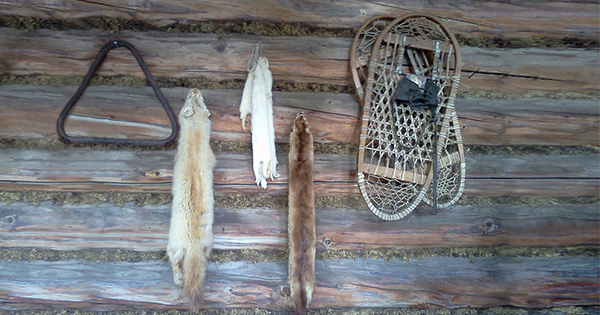
Jarl’s cabin is deep in the Interior, about 250 miles southwest of Fairbanks and near the tall banks of the Nakatna River, “the kind of banks you could pull a mastodon out of,” he explained simply. No towns, no roads—it’s an area that, aside from the endless fidgeting of rivers, has looked the same for many, many years.
Jarl, a friend of a friend, taught himself how to trap when he was 12 in northwestern Wisconsin, where he focused on water animals—beaver and muskrat. He would set his traps by bike in the fall; in winter, he’d go out on an old snowmachine.
At his cabin, which he built from logs milled onsite, Jarl’s mainstays are beaver and marten. He likes to fly there in late September when fall is rapidly turning to winter, but before real snows get in the way. He can take care of work around the cabin and check out which of the 100 or so beaver lodges in the area are active, so that he can mark the animals’ trails before ice forms on top of the water and snow erases everything.
Life at the cabin revolves around the weather, Jarl explained—“that’s one thing I love about it.” On the coldest days—minus 50 or less—nothing moves, not animals, not wind. Smoke rises from the chimney and then drops, coming to rest in a still layer on top of the snow among the tall spruce trees that surround the cabin.
Before he takes off from his cabin for the day, he repeats his Don’t Forget mantra: “Traps, wire, pliers, lure, bait.” If it’s colder than 30 degrees below, Jarl leaves the snowmachine at the cabin. The machine can be grumpy when it’s that frigid, and he doesn’t want to get caught far away from his cabin in lethal cold with a machine that won’t start. Instead, he heads out on snowshoes, the trudging necessary to keep him warm. He throws trapping gear into his pack and follows trails he’s cut himself. A typical day’s loop is eight miles. Lunch on the trail is a rock-hard peanut butter and jelly sandwich, frozen hours before in his pack.
When Jarl returns to a beaver trail that he’s marked, he shovels snow away and cuts a hole in the ice. He sets a spruce pole into the muck through the opening in the ice and then nails a piece of green wood—birch, alder, or willow—which is the bait. He attaches a small wire loop—the snare—to the pole near the bait. And then he covers the hole back up with ice and snow. He’ll come back in two or three days.
Among trappers, Jarl explains, he’s not very hardcore. Which means he doesn’t unfurl his bedroll along the trail in the evening so he can pick up his work the next day where he left off. Instead, he returns to his cabin at dusk and puts on the radio. Late into the night, the radio brings him programs from afar—first public radio out of McGrath (a tiny outpost along the Kuskokwim River about 100 miles away), then weird right-wing talk shows from the Lower 48. At three or four in the morning, voices from Japan and Russia become a strange kind of company in the dark.
Jarl and I talked in a small room at the Homer public library beneath fluorescent lights. He was waiting for a call to find out when he had to show up for his job as deckhand on the ferry, the job that delivers a reliable paycheck but keeps him from trapping.
Now that the pilot he regularly flew with to his cabin has retired, it’s more than four times as expensive to get there, and the finances of trapping don’t make much sense. But it makes all the sense in the world to Jarl to be out there, to live at the whim of the weather, and to spend the winter days working outside.
Here is a man who knows how to do many things: build a cabin in the woods miles from roads and electric lines, skin a marten, and stay sane alone in the dark, weeks after finishing the single bottle of whiskey he brought into the Bush. But he does not boast.
“Many days I have nothing,” Jarl says about a typical haul. But at the end of a hitch, his marten pelts go to a fur auction in North Bay, Ontario, through an agent in Fairbanks. He sends his other pelts to a tanner in Idaho and then sells them himself through word of mouth, mostly to a local artist who makes hats and mittens.
At 30 below, you can’t rush. A mistake could be deadly. Trapping requires patience, care, the ability to endure hours and hours of the cold in solitude. “When you sell them it’s quick,” Jarl said. “It’s all over. And all you have is money.”

